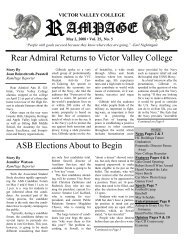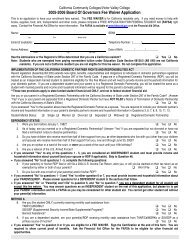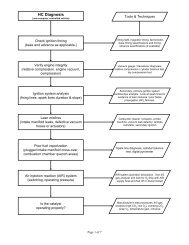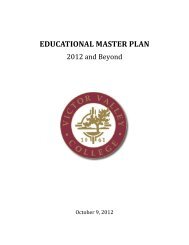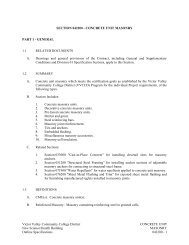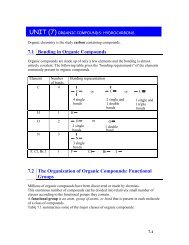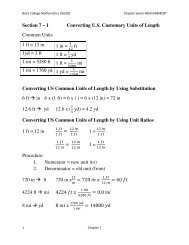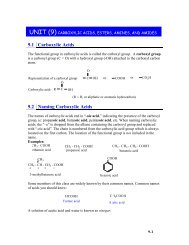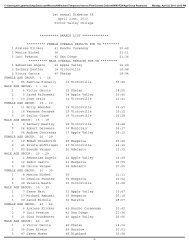Download - Victor Valley College
Download - Victor Valley College
Download - Victor Valley College
Create successful ePaper yourself
Turn your PDF publications into a flip-book with our unique Google optimized e-Paper software.
PROGRAMS / COURSE DESCRIPTION<br />
CHEMISTRY<br />
their roles in human metabolism. It is specifically<br />
designed for individuals directing nutrition programs,<br />
hospitals, and care centers of those acquiring degrees<br />
in allied health, child development, or restaurant<br />
management, as well as interested homemakers.<br />
Selected nutrition topics include personalized and<br />
vegetarian nutrition, menu planning, marketing options<br />
and chemistry of nutrition.<br />
CHEM 128 SPECIAL TOPICS<br />
See Special Topics listing (Variable units). CSU, UC<br />
CHEM 129 INDEPENDENT STUDY<br />
See Independent Study listing (1-3 units). CSU<br />
CHEM 138 COOPERATIVE EDUCATION<br />
See Cooperative Education listing (1-8 units). CSU<br />
CHEM 201 GENERAL CHEMISTRY<br />
Units: 4.0 - 48-54 hours lecture and 48-54 hours<br />
laboratory. CSU, UC. (Prerequisite: CHEM 100 or<br />
CHEM H100 with a grade of ‘C’ or better, and MATH 90<br />
or higher).<br />
Theories of atomic structure and the application of these<br />
theories to an understanding of bonding, solution<br />
processes, state of matter, gas laws, general properties<br />
of matter, and principles of stoichiometric calculations.<br />
Laboratory emphasis on the development of<br />
experimental skills, the calculations and significance of<br />
experimental data.<br />
CHEM 202 GENERAL CHEMISTRY<br />
Units: 4.0 - 48-54 hours lecture and 48-54 hours<br />
laboratory. CSU, UC. (Prerequisite: CHEM 201 with a<br />
grade of “C” or better, and MATH 90 or higher with a<br />
grade of “C” or better).<br />
Use of atomic theory developed in Chemistry 201 to<br />
examine the principles of periodic classification of the<br />
elements, thermodynamics, acids and bases, chemical<br />
equilibrium, reaction kinetics, coordination compounds.<br />
A basic survey of nuclear, organic, and biochemistry is<br />
included. Laboratory emphasis is on the development of<br />
technical skills.<br />
CHEM 206 INTRODUCTORY CHEMISTRY II:<br />
ORGANIC CHEMISTRY<br />
Units: 4.0 - 48-54 hours lecture and 48-54 hours<br />
laboratory. CSU, UC (UC credit limitation).<br />
(Prerequisite: CHEM 100 with a grade of “C” or better.)<br />
An introduction to fundamental concepts of Organic<br />
Chemistry for students entering professional careers in<br />
allied health. Emphasis is on the structure, reactivity and<br />
mechanisms, chemical properties and nomenclature of<br />
major organic functional groups and their relationship to<br />
biological systems.<br />
CHEM H206 HONORS INTRODUCTORY CHEMISTRY<br />
II: ORGANIC CHEMISTRY<br />
Units: 5.0 - 64-72 hours lecture and 48-54 hours<br />
laboratory. CSU. UC<br />
Modern organic synthesis, biotech, and pharmaceutical<br />
laboratories assess the feasibility of their proposed<br />
syntheses using computer generated models of target<br />
compounds. Current trends in modern research indicate<br />
a growing dependence on computational chemistry.<br />
This program will extend topics covered in CHEM 206<br />
into basic concepts of computational chemistry.<br />
Emphasis will be on molecular modeling techniques,<br />
acquisition, processing, and presentation of<br />
experimental data.<br />
CHEM 207 INTRODUCTORY CHEMISTRY III:<br />
BIOCHEMISTRY<br />
Units: 4.0 - 48-54 hours lecture and 48-54 hours<br />
laboratory. CSU, UC. (Prerequisite: CHEM 206 with a<br />
grade of “C” or better. Recent completion of CHEM 206<br />
or equivalent is recommended.)<br />
A one semester survey course in the fundamental<br />
principles of biochemistry for students entering<br />
professional careers in allied health. Emphasis is on the<br />
structure, function and physiological role of<br />
carbohydrates, lipids, proteins and nucleic acids.<br />
CHEM H207 INTRODUCTORY CHEMISTRY III:<br />
BIOCHEMISTRY HONORS<br />
Units: 5.0 - 64-72 hours lecture and 48-54 hours<br />
laboratory.<br />
The application of molecular modeling techniques to<br />
biological macromolecules. Computer generated forcefields<br />
and molecular graphics will be used to study<br />
structural geometry, potential energy surfaces, energy<br />
gradients, bond energies, and bond angles.<br />
Confirmational analyses will be performed to gain a<br />
practical understanding of the advantages and limitation<br />
of molecular modeling.<br />
CHEM 255 QUANTITATIVE ANALYSIS<br />
Units: 4.0 - 48-54 hours lecture and 48-54 hours<br />
laboratory. CSU, UC. (Prerequisite: CHEM 202 or year<br />
course in General Chemistry)<br />
Quantitative, gravimetric, volumetric, and instrumental<br />
methods of analysis. Stoichiometric calculations and<br />
applications of principles of chemical equilibrium to<br />
analytical problems. Laboratory accuracy required.<br />
158 2012-2013 <strong>Victor</strong> <strong>Valley</strong> <strong>College</strong> Catalog



